
Giovanni Coticchio, Danilo Cimadomo, Greta Chiara Cermisoni, Laura Rienzi, Enrico Papaleo, Filippo Maria Ubaldi, Andrea Borini, and Lucia De Santis
Human Reproduction, pp. 1–9, 2023, https://doi.org/10.1093/humrep/dead067 – Submitted on December 19, 2022; resubmitted on March 14, 2023; editorial decision on March 23, 2023; published 7 April 2023
Abstract
Human embryos are very frequently affected by maternally inherited aneuploidies, which in the vast majority of cases determine developmental failure at pre- or post-implantation stages. However, recent evidence, generated by the alliance between diverse technologies now routinely employed in the IVF laboratory, has revealed a broader, more complex scenario. Aberrant patterns occurring at the cellular or molecular level can impact at multiple stages of the trajectory of development to blastocyst. In this context, fertilization is an extremely delicate phase, as it marks the transition between gametic and embryonic life. Centrosomes, essential for mitosis, are assembled ex novo from components of both parents. Very large and initially distant nuclei (the pronuclei) are brought together and positioned centrally. The overall cell arrangement is converted from being asymmetric to symmetric. The maternal and paternal chromosome sets, initially separate and scattered within their respective pronuclei, become clustered where the pronuclei juxtapose, to facilitate their assembly in the mitotic spindle. The meiotic spindle is replaced by a segregation machinery that may form as a transient or persistent dual mitotic spindle. Maternal proteins assist the decay of maternal mRNAs to allow the translation of newly synthesized zygotic transcripts. The diversity and complexity of these events, regulated in a precise temporal order and occurring in narrow time windows, make fertilization a highly error-prone process. As a consequence, at the first mitotic division, cellular or genomic integrity may be lost, with fatal consequences for embryonic development.